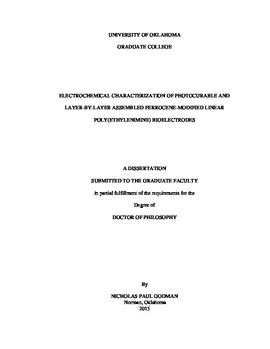| dc.contributor.advisor | Glatzhofer, Daniel | |
| dc.contributor.author | Godman, Nicholas | |
| dc.date.accessioned | 2015-07-31T19:33:07Z | |
| dc.date.available | 2015-07-31T19:33:07Z | |
| dc.date.issued | 2015 | |
| dc.identifier.uri | https://hdl.handle.net/11244/15464 | |
| dc.description.abstract | New methods of constructing enzymatic bioelectrodes based on ferrocene-modified linear poly(ethylenimine) (LPEI) were explored with the intent of lowering device fabrication times. Redox polymers were synthesized and characterized for usage as both anode and cathode materials.
Photolithography was used to form patterned films based on ferrocenylpropyl-modified linear poly(ethylenimine-co-allylethylenimine) (Fc-C3-LPAEI). Fc-C3-LPAEI (50% allylated, 5% ferrocene) films were crosslinked in the presence of glucose oxidase (GOX) using both photogenerated radicals and nitrenes. Biosensor efficiency was found to be a function of both polymer connectivity and enzyme stability. Fc-C3-LPAEI/GOX bioanodes were capable of generating 44.9 ± 1.3 µAcm-2 after five hours irradiation using a photogenerated dinitrene from 1,2-bis(2-azidoethoxy)ethane.
Both electrostatic and covalent layer-by-layer assembly were used for the fabrication of polymer/enzyme composite thin films. Ferrocenylhexyl- and ferrocenylpropyl- modified LPEI (Fc-C6-LPEI, Fc-C3-LPEI. 17-20% ferrocene) were used with periodate modified glucose oxidase (p-GOX) for the construction of enzymatic bioanodes capable of generating up to 381 ± 3 and 1417 ± 63 µAcm-2, respectively. Fc-C3-LPEI/p-GOX biofuel cells generated 86 ± 3 µWcm-2 at pH 7 when poised against an air-breathing Pt cathode. A chloroferrocene-modifed redox polymer (FcCl-C3-LPEI, 17-20% chloroferrocene) was assembled with laccase to construct biocathodes capable of generating up to 5.75 ± 0.14 µAcm-2 on planar gold electrodes and 32.3 ± 3.2 µAcm-2 on nitric acid oxidized carbon paper.
Lastly, sulfur and paracyclophane derivatives were copolymerized via inverse vulcanization to afford materials with the possibility of being incorporated in lithium-sulfur batteries. Differential scanning calorimetry was used to monitor the exothermic polymerization between the reactants, and the reaction parameters were optimized by varying the ratios of the starting materials. | en_US |
| dc.language | en_US | en_US |
| dc.subject | Biosensors | en_US |
| dc.subject | Electrochemistry | en_US |
| dc.subject | Polymers | en_US |
| dc.title | Electrochemical Characterization of Photocurable and Layer-By-Layer Assembled Ferrocene-Modified Linear Poly(ethylenimine) Bioelectrodes | en_US |
| dc.contributor.committeeMember | Nicholas, Kenneth | |
| dc.contributor.committeeMember | Yip, Wai Tak | |
| dc.contributor.committeeMember | Thomson, Robert | |
| dc.contributor.committeeMember | Crossley, Steven | |
| dc.date.manuscript | 2015 | |
| dc.thesis.degree | Ph.D. | en_US |
| ou.group | College of Arts and Sciences::Department of Chemistry and Biochemistry | en_US |
